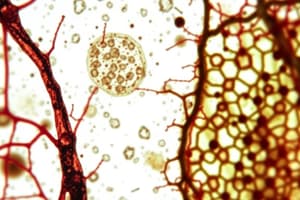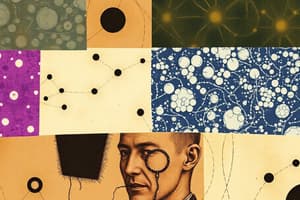Podcast
Questions and Answers
What percentage of the cytosol is composed of organic compounds?
What percentage of the cytosol is composed of organic compounds?
- 50%
- 18%
- 30% (correct)
- 65%
Which of the following compounds is classified as inorganic?
Which of the following compounds is classified as inorganic?
- Water (correct)
- Proteins
- Vitamins
- Nucleic acids
What function of the cell is primarily associated with the process of mitosis?
What function of the cell is primarily associated with the process of mitosis?
- Produce energy
- Facilitate transport
- Provide structure and support
- Facilitate growth (correct)
Which transport mechanism requires energy?
Which transport mechanism requires energy?
What is the primary site within cells for energy production?
What is the primary site within cells for energy production?
What type of reaction includes the breakdown of complex molecules to release energy?
What type of reaction includes the breakdown of complex molecules to release energy?
What characteristic do all true cells share?
What characteristic do all true cells share?
Which of the following statements correctly describes prokaryotic cells?
Which of the following statements correctly describes prokaryotic cells?
What term did Schwann introduce to describe the activities of cells?
What term did Schwann introduce to describe the activities of cells?
Which of the following is an exception to the cell theory?
Which of the following is an exception to the cell theory?
Which of the following was NOT one of the basic characteristics of true cells?
Which of the following was NOT one of the basic characteristics of true cells?
What did Schleiden contribute to the evolution of cell theory?
What did Schleiden contribute to the evolution of cell theory?
Which statement about viruses is correct?
Which statement about viruses is correct?
Which of the following characteristics is NOT typical of prokaryotic cells?
Which of the following characteristics is NOT typical of prokaryotic cells?
What is the structure of the bacterial chromosome?
What is the structure of the bacterial chromosome?
Where is the bacterial DNA located within the cell?
Where is the bacterial DNA located within the cell?
What type of proteins are found associated with prokaryotic DNA?
What type of proteins are found associated with prokaryotic DNA?
What distinguishes bacterial ribosomes from eukaryotic ribosomes?
What distinguishes bacterial ribosomes from eukaryotic ribosomes?
What role do 'R' factor plasmids play in bacterial cells?
What role do 'R' factor plasmids play in bacterial cells?
What is a key feature of mRNA synthesis in bacteria?
What is a key feature of mRNA synthesis in bacteria?
How do plasmids contribute to bacterial evolution?
How do plasmids contribute to bacterial evolution?
What specific function do colicin-producing plasmids serve in bacteria?
What specific function do colicin-producing plasmids serve in bacteria?
What is a fundamental characteristic of eukaryotic cells?
What is a fundamental characteristic of eukaryotic cells?
Which component primarily separates the contents of the nucleus from the cytoplasm in eukaryotic cells?
Which component primarily separates the contents of the nucleus from the cytoplasm in eukaryotic cells?
What term describes the fluid portion of the cytoplasm that exists outside the organelles?
What term describes the fluid portion of the cytoplasm that exists outside the organelles?
Which of the following is NOT considered a basic molecule of the cell?
Which of the following is NOT considered a basic molecule of the cell?
What primarily characterizes protoplasm?
What primarily characterizes protoplasm?
In which type of organisms are eukaryotic cells typically found?
In which type of organisms are eukaryotic cells typically found?
What is the primary role of nucleic acids in cells?
What is the primary role of nucleic acids in cells?
Which of the following statements about cytoplasm is correct?
Which of the following statements about cytoplasm is correct?
Which of the following statements accurately describes the physical nature of cytosol?
Which of the following statements accurately describes the physical nature of cytosol?
How many of the naturally occurring elements are typically found in cytosol?
How many of the naturally occurring elements are typically found in cytosol?
Which of the following elements constitutes the highest percentage in cytosol?
Which of the following elements constitutes the highest percentage in cytosol?
Which of the following ions has a high concentration inside the cell?
Which of the following ions has a high concentration inside the cell?
What role do trace elements play in cytosol?
What role do trace elements play in cytosol?
Which buffering system is associated with cytosol?
Which buffering system is associated with cytosol?
Which essential element found in cytosol constitutes 1.14%?
Which essential element found in cytosol constitutes 1.14%?
What is the function of ions like K+ and Mg++ in cytosol?
What is the function of ions like K+ and Mg++ in cytosol?
Study Notes
Cellular Structure and Theory
- Various microorganisms observed include bacteria (bacilli, cocci, spirilla), protozoa, and Hydra.
- Blood cells exhibit movement; significant for understanding circulatory functions.
- Schleiden identified nucleoli, emphasizing each cell's dual existence: independent development and as part of multicellular organisms.
- Schwann expanded cell theory showing living organisms consist of cells and their secretions and introduced the concept of metabolism.
Characteristics of True Cells
- True cells are characterized by:
- A set of genes acting as blueprints for cellular regulation and reproduction.
- A limiting plasma membrane that manages the exchange of matter and energy.
- Metabolic machinery essential for sustaining life, including growth and repair.
Exceptions to Cell Theory
- Viruses are exceptions as they lack protoplasm and utilize host cellular machinery for replication.
- Primitive organisms exist that do not meet the full criteria of cellular organization.
Cell Types
- The terms prokaryotic and eukaryotic cells were introduced by Hans Ris in the 1960s.
Prokaryotic Cells
- Considered primitive cells, characterized by:
- Small size and single envelope system.
- Existence dates back approximately 3.5 billion years.
- Contain a nucleoid with circular, double-stranded DNA, not enclosed in a nuclear membrane.
- Absence of ribosomes in the nucleoid and no nucleolus present.
Cellular Structures in Prokaryotes
- DNA is attached to the plasma membrane and carries membrane components upon isolation.
- Contains rRNA and proteins forming ribosomes, sized at 70s, involved in protein synthesis.
- Presence of plasmids, small circular DNA molecules, which can confer antibiotic resistance and assist in bacterial conjugation.
Eukaryotic Cells
- Eukaryotic cells have a well-developed, defined nucleus.
- Typically larger than prokaryotic cells with complex internal structures.
- Featuring a secondary membrane around the nucleus and other organelles like endoplasmic reticulum.
Protoplasm and Cytosol
- Protoplasm consists of living components made up of non-living substances interacting to support life.
- Cytosol, the fluid portion of cytoplasm, is colorless, viscous, and contains around 46 naturally occurring elements essential for life.
Composition of Cytosol
- Contains a mix of organic (30%) and inorganic (70%) compounds, with water making up about 65%.
- Key elements: Carbon (20%), Oxygen (62%), Hydrogen (10%), among others, play vital roles in cellular function.
Functions of Cells
- Provide structural framework and support to organisms.
- Facilitate growth via mitosis, allowing tissue and organ development.
- Enable active (energy-dependent) and passive (gradient-driven) transport of nutrients.
- Produce energy through respiration, largely facilitated by mitochondria.
- Conduct biochemical reactions, encompassing both anabolic and catabolic processes.
- Aid in reproduction through mitosis (asexual) and meiosis (sexual).
Studying That Suits You
Use AI to generate personalized quizzes and flashcards to suit your learning preferences.
Related Documents
Description
This quiz explores key concepts in cell biology, focusing on the structure and function of various microorganisms such as bacteria and protozoa. Additionally, it delves into the contributions of scientists like Schleiden to the cell theory, emphasizing the dual life of cells and their role in multicellular organisms.




